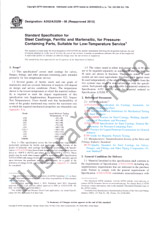Potřebujeme váš souhlas k využití jednotlivých dat, aby se vám mimo jiné mohly ukazovat informace týkající se vašich zájmů. Souhlas udělíte kliknutím na tlačítko „OK“.
ASTM D5045-14(2022)
Standard Test Methods for Plane-Strain Fracture Toughness and Strain Energy Release Rate of Plastic Materials
Přeložit název
NORMA vydána dne 1.11.2022
Informace o normě:
Označení normy: ASTM D5045-14(2022)
Datum vydání normy: 1.11.2022
Kód zboží: NS-1088717
Počet stran: 9
Přibližná hmotnost: 27 g (0.06 liber)
Země: Americká technická norma
Kategorie: Technické normy ASTM
Kategorie - podobné normy:
Anotace textu normy ASTM D5045-14(2022) :
Keywords:
critical-strain energy release rate, energy-to-break, fracture toughness, plane-strain fracture toughness,, ICS Number Code 83.080.01 (Plastics in general)
Doplňující informace
| Significance and Use | ||||||||
|
5.1?The property 5.1.1?The KIc (5.1.2?Plane-strain fracture toughness testing is unusual in that sometimes there is no advance assurance that a valid 5.1.3?Clearly, it will not be possible to determine 5.2?Inasmuch as the fracture toughness of plastics is often dependent on specimen process history, that is, injection molded, extruded, compression molded, etc., the specimen crack orientation (parallel or perpendicular) relative to any processing direction shall be noted on the report form discussed in 10.1. 5.3?Before proceeding with this test method, reference should be made to the specification of the material being tested. Any test specimen preparation, conditioning, dimensions, or testing parameters, or combination thereof, covered in the relevant ASTM materials specification shall take precedence over those mentioned in this test method. If there are no relevant ASTM material specifications, then the default conditions apply. |
||||||||
| 1. Scope | ||||||||
|
1.1?These test methods are designed to characterize the toughness of plastics in terms of the critical-stress-intensity factor, KIc, and the energy per unit area of crack surface or critical strain energy release rate, 1.2?Two testing geometries are covered by these test methods, single-edge-notch bending (SENB) and compact tension (CT). 1.3?The scheme used assumes linear elastic behavior of the cracked specimen, so certain restrictions on linearity of the load-displacement diagram are imposed. 1.4?A state-of-plane strain at the crack tip is required. Specimen thickness must be sufficient to ensure this stress state. 1.5?The crack must be sufficiently sharp to ensure that a minimum value of toughness is obtained. 1.6?The significance of these test methods and many conditions of testing are identical to those of Test Method E399, and, therefore, in most cases, appear here with many similarities to the metals standard. However, certain conditions and specifications not covered in Test Method E399, but important for plastics, are included. 1.7?This protocol covers the determination of GIc as well, which is of particular importance for plastics. 1.8?These test methods give general information concerning the requirements for KIc and 1.9?Test data obtained by these test methods are relevant and appropriate for use in engineering design. 1.10?This standard does not purport to address all of the safety concerns, if any, associated with its use. It is the responsibility of the user of this standard to establish appropriate safety, health, and environmental practices and determine the applicability of regulatory limitations prior to use. Note 1:?This standard and ISO 13586 address the same subject
matter, but differ in technical content.
1.11?This international standard was developed in accordance with internationally recognized principles on standardization established in the Decision on Principles for the Development of International Standards, Guides and Recommendations issued by the World Trade Organization Technical Barriers to Trade (TBT) Committee. |
||||||||
| 2. Referenced Documents | ||||||||
|




 Cookies
Cookies
